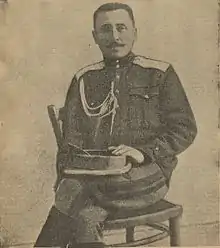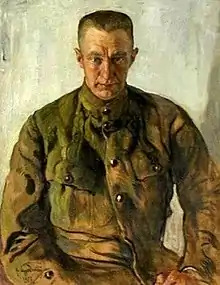| Kerensky–Krasnov uprising | |||||||
|---|---|---|---|---|---|---|---|
| Part of the Russian Civil War | |||||||
| |||||||
| Belligerents | |||||||
|
|
| ||||||
| Commanders and leaders | |||||||
|
|
| ||||||
| Strength | |||||||
| ~5,000 men |
700 men (of which 600 cavalry) 12 cannons 1 armoured vehicle | ||||||
The Kerensky–Krasnov uprising was an attempt by Alexander Kerensky to crush the October Revolution and regain power after the Bolsheviks overthrew his government in Petrograd. It took place between 8 and 13 November 1917 [O.S. 26 and 31 October].
Following the October Revolution, Kerensky fled Petrograd, which fell to the Bolshevik-controlled Petrograd Soviet and went to Pskov, the headquarters of the Northern Front command. He did not get the support of its commander, General Vladimir Cheremisov, who prevented his attempts to gather units to march on Petrograd, but he did get the support of General Pyotr Krasnov, who advanced on the capital with about 700 Cossacks. In Petrograd, opponents of the October Revolution were preparing a revolt that would coincide with the attack on the city by Kerensky's forces.
The Soviets had to improvise the defense of the hills south of the city and wait for the attack of Kerensky's troops, who, despite the efforts of the high command, received no reinforcements. The clash in the Pulkovo Heights ended with the withdrawal of the Cossacks after the Junker mutiny, which failed prematurely, and they did not receive the necessary support from other units to force the defences. Talks between the sides ended with Kerensky's flight, fearful of being handed over to the Soviets by his own soldiers, effectively ending attempts to restore the overthrown Russian Provisional Government.
Background

Alexander Kerensky, who had left Petrograd during the October Revolution,[1] looked for troops that might come to the capital, but did not find them until he arrived to Pskov,[2] where he arrived around 9 pm on 25 October [O.S. 7 November].[3][4][5] In the first town with troops near the capital, Gatchina, the soldiers were pro-Bolshevik, and Kerensky narrowly escaped arrest.[3][5]
In Pskov was the headquarters of the Northern Front under the command of General Cheremisov;[3] there Kerensky came into contact with General Pyotr Krasnov, commander of the 3rd Cavalry Corps, which participated in the Kornilov putsch.[1][2][4][6][7][8] Together they gathered a Corps to march over the capital, despite the doubts of his commissar, who was suspicious of the reliability of some troops who were hostile to Kerensky.[2] Krasnov, a monarchist officer, was not a great a supporter of Kerensky, but believed his claim that the majority of the army would support him against the Bolsheviks.[8]
In turn, Cheremisov, whose troops were effectively under Bolshevik control and who had bad relations with Kerensky, had rescinded[4][8] the orders to help the Provisional Government by sending him to Petrograd.[3] Upon his arrival, I had informed him that he could not guarantee his safety if he remained in the city and that he had to leave immediately.[4] Cheremisov refused to help the former prime minister.[9][8] The local Military Revolutionary Committee controlled communications and transport and monitored the actions of the commanders.[4] Cheremisov had also obstructed Kerensky's communications with the others. commanders of the front and communicated to the high command his appointment as commander-in-chief and the order to stop the march of troops on the capital, both false reports.[6]
Military operations
On the night of 26 October [O.S. 8 November], Kerensky was again on the outskirts of the capital with little over six hundred Cossacks[10][8] — twelve and a half squads of sixty men[4] — some cannons,[2] an armored convoy and an armored car.[4] The dispersion of the III Corps and the lack of support for Kerensky among the troops prevented the assembly of larger forces,[4] and only those that were stationed in Ostrov marched towards the capital.[8] Krasnov, however, was confident that his cossack troops would receive reinforcements.[8] The few Cossacks crossed Pskov by train at full speed to avoid clashes with the troops occupying the station and continued towards Gatchina.[8]

The next morning,[8] troops took Gatchina[10] without encountering resistance and prepared to assault the Bolshevik positions[2] while awaiting reinforcements.[11] Various circumstances, however, prevented the arrival of new forces to Kerensky: the neutrality of many officers in the conflict, such as the commander of the Northern Front, General Cheremisov, the refusal of the majority of the army to fight, the growing influence of the Bolsheviks in the troops and the reluctance of railway workers to collaborate in the operation.[2][10] Cheremisov, with bad relations with Kerensky due to a previous personal offense, had ordered that none troops were sent to the capital the day before, declaring that the army should not mix in politics.[12] Kerensky received only reinforcements from an armored convoy and a regiment from Luga.[12] In Gatchina, only a few officers from the aviation school joined Krasnov's Cossacks; contributed a couple of planes and an armored car and dropped leaflets over the capital.[8] After midnight on 28 October [O.S. 10 November], your small forces, whose size was exaggerated by the government of Lenin who believed they were much larger, took the Tsarskoye Selo.[13][14][1] Here the first fight took place; Krasnov, however, drove out the Red Guards with his light artillery.[8] His advance, however, was slow[7] due to lack of reinforcements,[15] especially infantry.[14] At Tsarskoye Selo, the great garrison — sixteen thousand men — who outnumbered Krasnov's forces twenty to one, declared his neutrality[16] in the confrontation.[14][8] In turn, the Bolshevik Revolutionary Military Committee prepared to defend the capital and sent forward the best troops it had in Petrograd.[13] Red Guards, civilians and sailors[15] joined the garrison units that departed south of the city to mount defenses.[17][16] The command has been placed in the hands of Colonel Muraviov,[15] to whom Chudnovsky was attached as a commissioner; Trotsky and Pavel Dybenko accompanied them to supervise the operation.[17]
Meanwhile, in Petrograd, ex-ministers Mensheviks encouraged officials to oppose the new Bolshevik government, the Sovnarkom, through strikes, and supporters of the old government, coordinated by the Committee for the Salvation of the Homeland and Revolution, controlled by the Socialist Revolutionary Party (PSR), planned a revolt simultaneously with Kerensky's impending attack.[17] The presidency of the dissolved Preparliament called for a revolt against the Lenin government.[17] The chief military commissar of the deposed Provisional Government, Stankevich, left to meet[15] with Kerensky in Gatchina to coordinate the revolt in the city and the advance of Kerensky's troops.[17]
After the failure of the junker mutiny in Petrograd, which had to be precipitated when it was discovered, some members of the PSR Central Committee joined Kerensky after fleeing the capital.[18][14] Krasnov's troops made no attempt to help the rebels in the capital.[15] Avram Gots supported the search for infantry to reinforce the Cossacks on their march on the capital, both at the front and in the garrisons around the city, which had thousands of soldiers.[19] At the front, the Mensheviks and Social Revolutionaries predominated in the unit committees, but not among the soldiers, who were increasingly close to the Bolsheviks.[19] The army closest to the capital, the 12th, belonging to the Northern Front and with two pro-Bolshevik Latvian divisions selected, elected its council, which turned out to consist of supporters and opponents of the October Revolution; the few units sent to the capital refused to advance beyond Valka.[19] The other two armies on the Northern Front, the 1st and 5th. º, were even more pro-Bolshevik and opposed to Kerensky's support.[20] For their part, the Gatchina and Tsarskoye Selo garrisons had declared themselves neutral and did not support the attack by Kerensky to the capital.[21] In the end, various efforts to obtain more troops, either from the front or from the nearby garrisons, proved fruitless.[22]
On 30 October [O.S. 12 November], 1917, faced with reports of excesses in the capital after the crushing the revolt of the cadets, tried to advance from the Tsarskoye Selo against the entrenched Bolshevik forces, which were twenty times as numerous.[22] Despite advancing easily against the Red Guards, the Cossacks found themselves in danger of being attacked on their flanks[23] by the marines[7][15] commanded by Dybenko.[23] The Cossacks were repulsed [16] in the Pulkovo Heights and had to evacuate Tsarskoye Selo and return to Gatchina to avoid being surrounded.[22][24][23][15] The confrontation had been messy and bloody.[23] The forces of Kerensky began to disperse in retreat and some of them fraternized with the Bolsheviks in hopes of returning home.[25] Lack of support had sapped the morale of Kerensky's few Cossack troops.[7]
By 1 November [O.S. 14 November], the situation had deteriorated to the point that Kerensky he was in danger of being arrested by his own men and handed over to the Bolsheviks; the leaders of the Socialist Revolutionary Party forced him to flee dressed [16] as a sailor.[25][24][23][26] Kerensky's escape ended hopes of restoring the Provisional Government;[24] after that the opponents of the October Revolution did not try to revive it, but to create a new alternative government to the Bolsheviks.[27] The defeat of Kerensky, together with the Bolshevik victory in the heavy fighting in Moscow, temporarily secured the power of Lenin and his supporters;[26] the capital was temporarily safe from military attack.[16]
In turn, Krasnov was captured, but soon released after promising not to fight the Soviet authorities, a promise he quickly broke[7][26] by becoming the leader of an anti-Bolshevik movement — the Don Republic.[26]
Citations
- 1 2 3 Wade 2000, p. 244.
- 1 2 3 4 5 6 Radkey 1963, p. 14.
- 1 2 3 4 Daniels 1997, p. 200.
- 1 2 3 4 5 6 7 8 Rabinowitch 1978, p. 305.
- 1 2 Chamberlin 1976, p. 329.
- 1 2 Daniels 1997, p. 201.
- 1 2 3 4 5 Kenez 1971, p. 46.
- 1 2 3 4 5 6 7 8 9 10 11 12 Chamberlin 1976, p. 330.
- ↑ Kenez 1971, p. 45.
- 1 2 3 Daniels 1997, p. 203.
- ↑ Rabinowitch 1978, p. 306.
- 1 2 Radkey 1963, p. 15.
- 1 2 Radkey 1963, p. 29.
- 1 2 3 4 Daniels 1997, p. 205.
- 1 2 3 4 5 6 7 Chamberlin 1976, p. 331.
- 1 2 3 4 5 Wade 2000, p. 245.
- 1 2 3 4 5 Daniels 1997, p. 204.
- ↑ Radkey 1963, p. 39.
- 1 2 3 Radkey 1963, p. 40.
- ↑ Radkey 1963, p. 43.
- ↑ Radkey 1963, p. 44.
- 1 2 3 Radkey 1963, p. 45.
- 1 2 3 4 5 Rabinowitch 1978, p. 308.
- 1 2 3 Daniels 1997, p. 206.
- 1 2 Radkey 1963, p. 46.
- 1 2 3 4 Chamberlin 1976, p. 332.
- ↑ Radkey 1963, p. 47.
References
- Chamberlin, William Henry (1976). The Russian revolution, 1917-1918: from the overthrow of the czar to the assumption of power by the bolsheviks. New York: Grosset & Dunlap. pp. 511. ISBN 9780448001883.
- Daniels, Robert Vincent (1997). Red October: the Bolshevik Revolution of 1917. Boston: Beacon Press. p. 269. ISBN 9780807056455.
- Kenez, Peter (1971). Civil War in Southern Russia 1918. California: University of California Press. p. 416. ISBN 9780520017092.
- Rabinowitch, Alexander (1978). The bolsheviks come to power. The revolution of 1917 in Petrograd. New York: W. W. Norton & Company. p. 393. ISBN 9780393008937.
- Radkey, Oliver H. (1963). The sickle under the hammer; The Russian Socialist Revolutionaries in the early months of the Soviet rule. New York: Columbia University Press. pp. 525. OCLC 422729.
- Wade, Rex A. (2000). The Russian Revolution, 1917 (New Approaches to European History). Cambridge: Cambridge University Press. p. 337. ISBN 9780521425650.